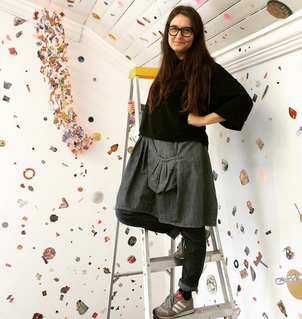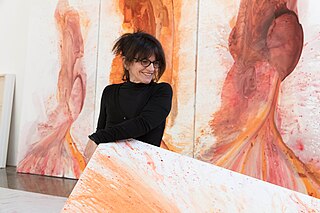Related Research Articles

Johnny Lee Coffelt born is an American artist who lives and works in Brooklyn New York City. Coffelt paints, sculpts, sews, makes book arts, and curates art exhibitions.

The Iziko South African National Gallery is the national art gallery of South Africa located in Cape Town. It became part of the Iziko collection of museums – as managed by the Department of Arts and Culture – in 2001. It then became an agency of the Department of Arts and Culture. Its collection consists largely of Dutch, French and British works from the 17th to the 19th century. This includes lithographs, etchings and some early 20th-century British paintings. Contemporary art work displayed in the gallery is selected from many of South Africa's communities and the gallery houses an authoritative collection of sculpture and beadwork.
Berni Searle is an artist who works with photography, video, and film to produce lens-based installations that stage narratives connected to history, identity, memory, and place. Often politically and socially engaged, her work also draws on the universal emotions associated with vulnerability, loss and beauty.

Judith Mason born Judith Seelander Menge was a South African artist who worked in oil, pencil, printmaking and mixed media. Her work is rich in symbolism and mythology, displaying a rare technical virtuosity.
Peter Clarke was a South African visual artist working across a broad spectrum of media. He was also a writer and poet.

The Pretoria Art Museum is an art gallery located in Arcadia, Pretoria in South Africa. The museum in Arcadia Park occupies an entire city block bounded by Park, Wessels, Schoeman and Johann Streets.
Sara Garden Armstrong is an American artist who lives and works in New York City. Armstrong creates sculptures, paintings, drawings, artist's books, multimedia artworks involving computers sound and light, and constructs permanent installations in atrium spaces. Armstrong received her Master of Fine Arts from the University of Alabama in Tuscaloosa and her Master of Art Education from the University of Alabama at Birmingham. Armstrong also studied art at New York University and with the University of Windsor, Windsor, Ontario in Yeovil, England while attending UAB. She was an educator for several years at the University of Alabama at Birmingham, later she moved to New York City in 1981.
Gary Schneider is a South African-born American photographer known for his portraiture and self-portraits. According to the John Simon Guggenheim Memorial Foundation, which awarded him a Guggenheim Fellowship in 2013, his "early work in painting, performance, and film remain integral to his explorations of portraiture. He strives to marry art and science, identity and obscurity, figuration and abstraction, the carnal and the spiritual."
Nandipha Mntambo is a South African artist who has become famous for her sculptures, videos and photographs that focus on human female body and identity by using natural, organic materials.
Ruth Sacks is a South African artist who lives and works in Johannesburg. She is currently a postdoctoral researcher in the South African Research Chair Initiative (SARChI) for Social Change at Fort Hare University. Sacks holds a PhD (Arts) from the University of the Witwatersrand where she was a fellow at the Wits Institute for Social and Economic Research (WiSER). Her third artist book, Twenty Thousand Leagues Under Seas, was launched in 2013. She is a laureate of the HISK in Ghent. She was one of the facilitators of the artist-run project space the Parking Gallery, hosted by the Visual Arts Network of South Africa (VANSA) in Johannesburg. Ruth Sacks' work has been presented internationally in venues such as the African Pavilion at the 52nd Venice Biennalein 2007, the ZKM Centre for Art and Media, Karlsruhe in 2011 and the National Museums of Kenya, Nairobi in 2017.
James Webb is a South African artist best known for his interventions and installations incorporating sound. Webb also works as a sound designer, curator and teacher. His sound installations place special emphasis on the sourcing and presentation of the sound clips, as well as the social significance and context of these sounds. Often referred to as a "collector of sounds," Webb is interested in the role that aural events play in our everyday life. The physical presentation of the work, including the installation space and the logistics of speakers, are also deliberate choices for Webb.

Ashley Walters is a South African-born and based artist who works with photography and film.

Julia Rosa Clark is a South African contemporary artist and educator known for her "graphically complex, textually coded and colour-rich paper installations."

Sue Williamson is an artist and writer based in Cape Town, South Africa.

Penny Siopis is a South African artist from Cape Town. She was born in Vryburg in the North West province from Greek parents who had moved after inheriting a bakery from Siopis maternal grandfather. Siopis studied Fine Arts at Rhodes University in Makhanda, completing her master's degree in 1976, after which she pursued postgraduate studies at Portsmouth Polytechnic in the United Kingdom. She taught Fine Arts at the Technikon Natal in Durban from 1980 to 1983. In 1984 she took up a lectureship at the University of the Witwatersrand in Johannesburg. During this time she was also visiting research fellow at the University of Leeds (1992–93) and visiting Professor in Fine Arts at Umeå University in Sweden (2000) as part of an interinstitutional exchange. With an Honorary Doctorate from Rhodes University, Makhanda – Siopis is currently Honorary Professor at Michaelis School of Fine Art, University of Cape Town.

Wayne Barker, South African visual artist. Barker is based in Johannesburg. He rose to prominence in the late 80s, at the height of political unrest under the Apartheid regime. His work has featured in several global biennales, art fairs and important retrospective exhibitions. He works in various mediums, including but not limited to painting, printmaking, sculpture, video, performance and installation. In addition to collaborations with other artists, Barker has collaborated with the Qubeka Beadwork Studio based in Cape Town, to realise large scale glass beadworks.
iQhiya is a network of young black women artists based in Cape Town and Johannesburg, South Africa. They specialise in a broad range of artistic disciplines including performance art, video, photography, sculpture and other mediums.

Jeannette Unite is a South African artist who has collected oxides, metal salts and residues from mines, heritage and industrial sites to develop paint, pastel and glass recipes for her large scale artworks that reflect on the mining and industrial sites where humanity's contemporary world is manufactured.
Buhlebezwe Siwani is a multidisciplinary artist known for her work in performance art, installations, and photographic stills.
Gerald Machona is a Zimbabwean Visual contemporary artist .The most recognizable aspect of his work is his use of decommissioned Zimbabwean dollars. Machona works in sculpture, performance, new media, photography and film. In Machona's work, he explores issues of migration, transnationality, social interaction and xenophobia in South Africa.